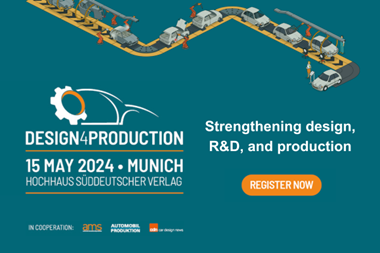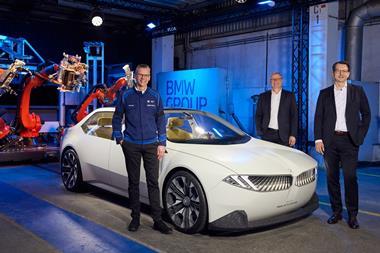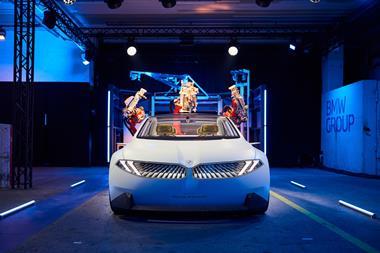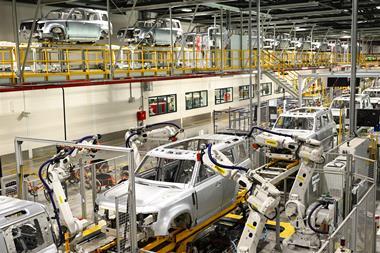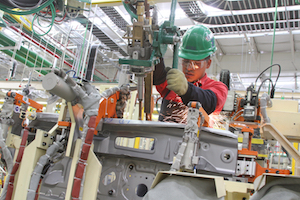 After nine days of traipsing across Mexico to visit even the remotest automotive facilities, Aguascalientes ('Hot Springs') sounds like an ideal stopping point on my journey, with its distinctly spa-like connotations. But this is no time for a back rub. It's Nissan I've come to visit, and the only water is of the kind that is familiar to any Brit: cold and falling from the sky. Yet while a hurricane off the coast has thrown the local climate out of whack, all is calm at the plant. This is something that Nissan Aguascalientes prides itself on: the orderly operation of one of the largest and most productive automotive manufacturing sites in Mexico, comprising not one but two vehicle plants (A1 and A2), plus an engine facility, on 4.6m sq.m of land.
After nine days of traipsing across Mexico to visit even the remotest automotive facilities, Aguascalientes ('Hot Springs') sounds like an ideal stopping point on my journey, with its distinctly spa-like connotations. But this is no time for a back rub. It's Nissan I've come to visit, and the only water is of the kind that is familiar to any Brit: cold and falling from the sky. Yet while a hurricane off the coast has thrown the local climate out of whack, all is calm at the plant. This is something that Nissan Aguascalientes prides itself on: the orderly operation of one of the largest and most productive automotive manufacturing sites in Mexico, comprising not one but two vehicle plants (A1 and A2), plus an engine facility, on 4.6m sq.m of land.
Although, sadly, there is no panpipe music, several other features contribute to the harmonious production of well over half a million units per year. All incoming components are directed through one main entrance and, once inside, quietly transported by electric conveyors; the bodies themselves float serenely on pallet-like automated guided vehicles and flow out of the paintshop on an electric friction-drive system. More importantly, Aguascalientes follows the Douki Seisan ('Synchronised Production') philosophy to streamline inventory and avoid any disruption by sequencing the manufacturing process, components, suppliers, shipments and delivery to dealers.
But beneath the placid surface, a vast amount of energy is bubbling away – though less thermal, more kinetic. A1, which opened in 1992, has the fastest assembly line in Nissan's global production network, churning out five models at a rate of 65jph – one vehicle every 55 seconds – even though it was built to handle only 60jph, like Smyrna in the US. The engine facility at A1 makes no fewer than ten types of engine at a rate of one every 17 seconds – also one of the OEM's fastest worldwide. And although Douki Seisan is part of the standard Nissan Production Way, Aguascalientes has been so successful in its practice that it has achieved a leading score of 99% on the sequence measure index, a significant factor in its productivity. This is all the more impressive in the wider context of the Renault-Nissan Alliance; out of 48 plants worldwide, Aguascalientes achieves the highest volume per line.
I ask Armando Avila, vice-president of Manufacturing at Nissan Mexicana, what is the source of this success? People, he says, are the difference, in particular the nurturing of their desire always to reach a higher level. Indeed, reinvigorating training was one of the first actions Avila took on arriving at A1 in 2000. Aguascalientes now exports its techniques to the UK, Spain and even back to Japan, and leads training for the Alliance in the Americas. According to Avila, it's vital, too, that the site is run by Mexicans, including not only himself but both plant managers. “The Japanese trust in us,” he says. This contrasts starkly with the imported hierarchies of other carmakers in Mexico, and helps to explain Aguascalientes' smooth operation from top to bottom.
Nissan has had a manufacturing presence in Mexico since 1966, when it established the Cuernavaca plant, Morelos State, and currently boasts some very healthy figures – 431,000 units produced up to June this year and also a 27% share of the domestic market. But it's essential even for this expert not to get too comfortable. From 2016 until 2019, rivals will add no fewer than five vehicle plants in Mexico, with new Kia and Audi operations already open for business and Toyota, Ford and BMW factories all waiting in line.
However, far from relaxing, Nissan is joining the flood of investment by developing a new, $1 billion facility together with Daimler. The Cooperation Manufacturing Plant Aguascalientes (COMPAS) will have a capacity of 230,000 units per year and produce Infiniti models from 2017, followed by Mercedes A- and B-class cars from 2018. This will not only raise Nissan's total output in the country from around 850,000 in 2016 to over 1m in 2019, but tap into the growing need for production of premium vehicles (albeit mostly for export). Nor are Aguascalientes' existing operations running out of steam. A2, which opened in 2013 and makes the Sentra, is installing new equipment to go from 32jph to 42jph from next year and, depending on demand, could also reach 60jph or more. Given the strong growth in Mexico and Avila's firm belief in exceeding expectations, this seems entirely possible. Nissan Mexicana's VP of Manufacturing is also chairman of the upcoming COMPAS plant; I think we can say it's in good hands.

























